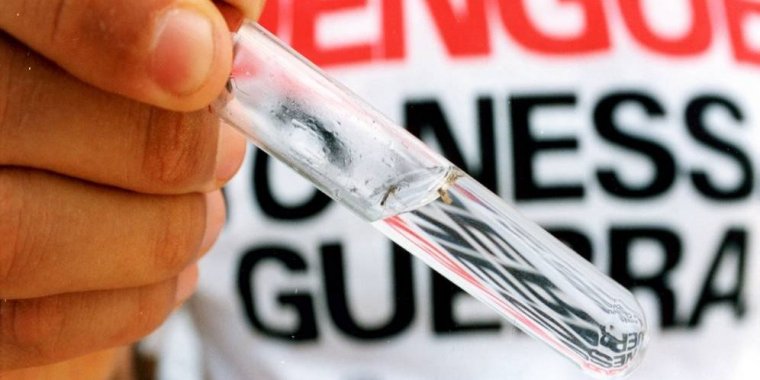| News / Science News |
Gold nanosensor spots difference between dengue, Zika
A new class of nanosensor developed in Brazil could more accurately identify dengue and Zika infections, a task that is complicated by their genetic similarities and which can result in misdiagnosis.

Distinguishing between dengue and Zika viruses is complicated because of their genetic similarities. Photo: Peter Ilicciev/Fundación Oswaldo Cruz.
The technique uses gold nanoparticles and can “observe” viruses at the atomic level.
Belonging to the Flavivirus genus in the Flaviviridae family, Zika and dengue viruses share more than 50 per cent similarity in their amino acid sequence.
Both viruses are spread by mosquitos and can have long-term side effects. The Flaviviridae virus family was named after the yellow fever virus and comes from the Latin word for golden, or yellow, in colour.
“Diagnosing [dengue virus] infections is a high priority in countries affected by annual epidemics of dengue fever. The correct diagnostic is essential for patient managing and prognostic as there are no specific antiviral drugs to treat the infection,” the authors say.
Flávio Fonseca, study co-author and researcher at the Federal University of Minas Gerais, tells it is almost impossible to differentiate between dengue and Zika viruses.
“A serologic test that detects antibodies against dengue also captures Zika-generated antibodies. We call it cross-reactivity,” he says.
Co-author and virologist, Maurício Nogueira, tells that avoiding cross-reactivity is crucial because “dengue is a disease that kills — and can do so quickly if the right diagnosis is not made. As for Zika, it offers risks for foetuses to develop microcephaly, and we can’t let pregnant women spend seven or eight months wondering whether they have the virus or not.”
There is also no specific antiviral treatment for Zika and the search for a vaccine is ongoing.
Virus differentiation is important to accurately measure the real impact of both diseases on public health. The most widely used blood test, the enzyme-linked immunosorbent assay (ELISA), is limited in its ability to tell the difference between the viruses, the authors say.
As dengue has four variations, known as serotypes, the team created four different nanoparticles and covered each of them with a different dengue protein. They applied ELISA serum and a blood sample.
The researchers found that sample antibodies bound with the viruses’ proteins, changing the pattern of electrons on the gold nanoparticle surface.
“We can see this change by applying certain frequencies of light on the nanoparticle’s surface. Dengue proteins absorbed light — Zika ones did not,” Fonseca says. Nogueira, who coordinated the project, adds that the results were important to calibrate the tests with the gold nanoparticles.
Juliana Cortines, a virologist at the Federal University of Rio de Janeiro, who was not involved in the study, is enthusiastic about the results.
“The fact that this test doesn’t require reagents and uses ELISA equipment, which is widely available, is very important because the countries that suffer the most with Zika and dengue are poor”.
The study argues that the gold nanoparticle-based test is more precise than other blood antibody tests because of its high sensitivity and capacity to identify which virus has been detected. (SciDev.Net)
YOU MAY ALSO LIKE





